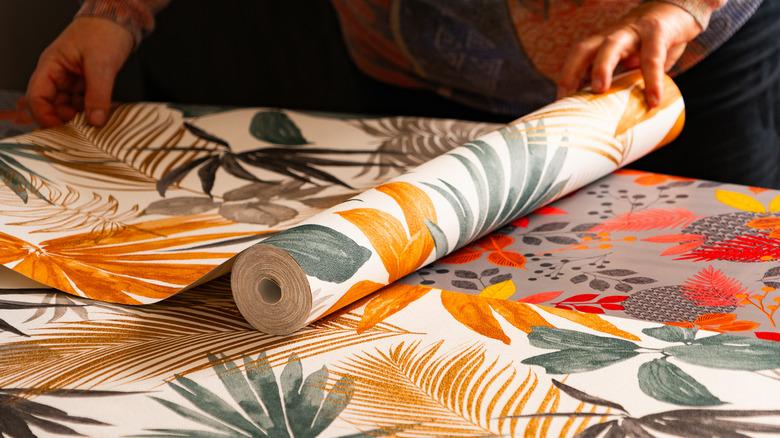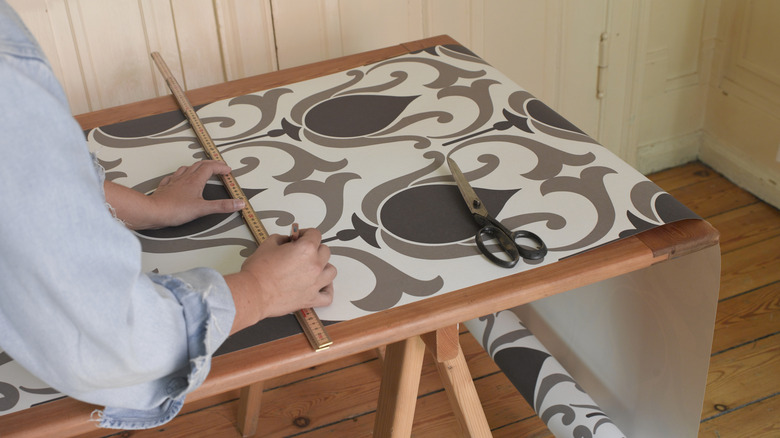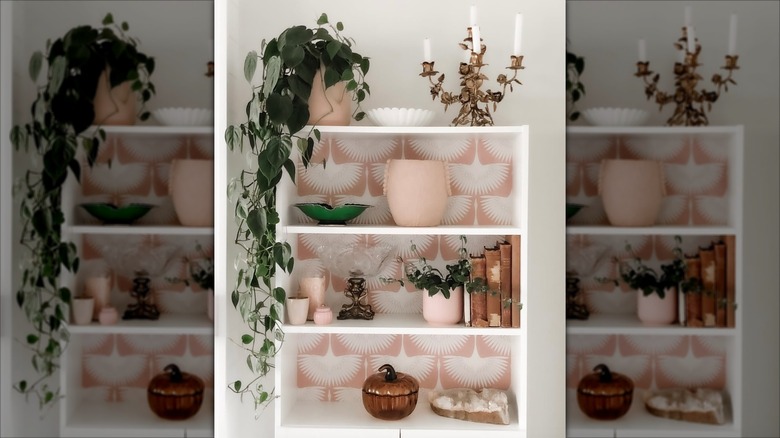London Design Week Has Proven That Repurposing With Wallpaper Is A Huge Trend This Year
Wallpaper is one of the most polarizing accents in the design world. Big, bold prints covering a large wall can make or break the space, and for many, it's simply not worth the risk. Patterns can go out of style quickly, prints that seemed subtle in a sample can read as overwhelming on a large scale, and installation can be difficult and expensive. Because of this, many people choose to stick with paint as a way to spruce up a room, bypassing wallpaper as an option entirely. But what if there were more innovative ways to use wallpaper that don't involve plastering it over your entire space? According to attendees at this year's London Design Week, one of the biggest trends involves wallpaper being used as a subtle way to upgrade boring pieces.
In recent years, maximalist decor has been rising in popularity, putting an end to the decades-long reign of sleek, simple, and neutral spaces. Instead of shopping for items that effortlessly blend in, many are beginning to gravitate towards pieces that showcase their personality. This is evident in the trends displayed at London Design Week — bold colors, kitchy accents, and mixed patterns dominated showcases — but not everyone is ready to completely throw caution to the wind and embrace the chaos of a true maximalist interior. One of the more approachable ways to lean into this shift is by adding a bit more pattern to a room's design, and this can be accomplished with the help of wallpapered decor pieces.
Restyling with wallpaper
Whether you've been eyeing a roll of beautifully-patterned wallpaper but aren't ready to take the plunge into a full-room revamp, have some excess material laying around from your last renovation, or are looking to update some items that fall flat design-wise, this trend is for you. Wallpaper DIYs are typically inexpensive (especially if you already have the materials you need), easy to accomplish, and a great way to breathe new life into existing items that don't quite fit your desired style.
There are plenty of different ways to pull this off, but some of the most compelling examples include wallpapered picture frames, trash cans, and tissue boxes. These are small, simple accents that are typically pretty basic, but a few sheets of wallpaper can turn them into a piece that stands out instead of blending into the background. Starting off with items like these can help you dip your toes in the water and try out this DIY without much risk, but if you're feeling more confident, you can also extend the idea to larger furniture pieces.
How to revamp decor with wallpaper
When it comes to choosing a wallpaper, you have two main types to choose from: traditional and peel-and-stick. Traditional wallpaper requires the use of an additional adhesive and is intended to hang on drywall, but it can work for some DIY projects, especially covering wood furniture. If you want to make it easy on yourself, however, peel-and-stick is the way to go. This style of wallpaper already has an adhesive backing and will stick to a larger variety of surfaces, so it's a safer bet for most items. Because of its ease of application and removal, it's also become a popular renter-friendly upgrade, so there are tons of different patterns available at a wide range of price points.
Once you've decided on a wallpaper, you're ready to get started. Begin by preparing the item that you want to cover. It needs to be clean, smooth, and dry, so make sure that you've cleared away any dust or debris. If you've ever applied a screen protector on your phone, the process is fairly similar. Cut your piece of peel-and-stick wallpaper to your desired size, leaving a bit of excess, and remove a small amount of the backing to adhere it to the surface. Gradually peel away the rest of the backing, smoothing as you go. If you have any bubbles, you can go in with a scraper or a credit card to push them out. Trim up the edges with a hobby knife for a precise finish, and you're set.
What items should you cover with wallpaper?
If you opt for peel-and-stick wallpaper for this DIY, the world is your oyster. As long as the item that you want to cover has a smooth, flat, and hard surface, it's fair game. This includes solid trash cans, small floating shelves, picture frames, mirrors, cabinet doors, tissue boxes, and plenty of others. Shelving units and bookcases are also a popular choice. You can cover the entire thing if you're planning to create a bold statement piece, or, for a more subtle accent, only apply your wallpaper to the backing so you have a pop of pattern peeking through the shelves. This is also a great idea to consider if you're working with laminate items. Sometimes furniture surfaces don't take paint well, so some peel-and-stick wallpaper can help to refresh the piece and cover any damage without you having to worry about peeling.
Traditional wallpaper, on the other hand, will leave you a bit more limited. Wallpaper adhesive will stick well to sanded wood items, but pieces made of plastic or glass might not be the best bet. For plastic items, give them a sand and try a test strip before committing to the full project. When it comes to glass, you'll have to use double-sided tape. While the process is a bit more difficult with traditional wallpaper, it's certainly still possible to use to redecorate your items.


